Georgia WWSCAN Biweekly Newsletter Update 12/8/23
Welcome to the bi-weekly update for WWSCAN partners in Georgia! The samples provided up through 12/6/23 have been processed in the lab and data are on the site at data.wastewaterscan.org.
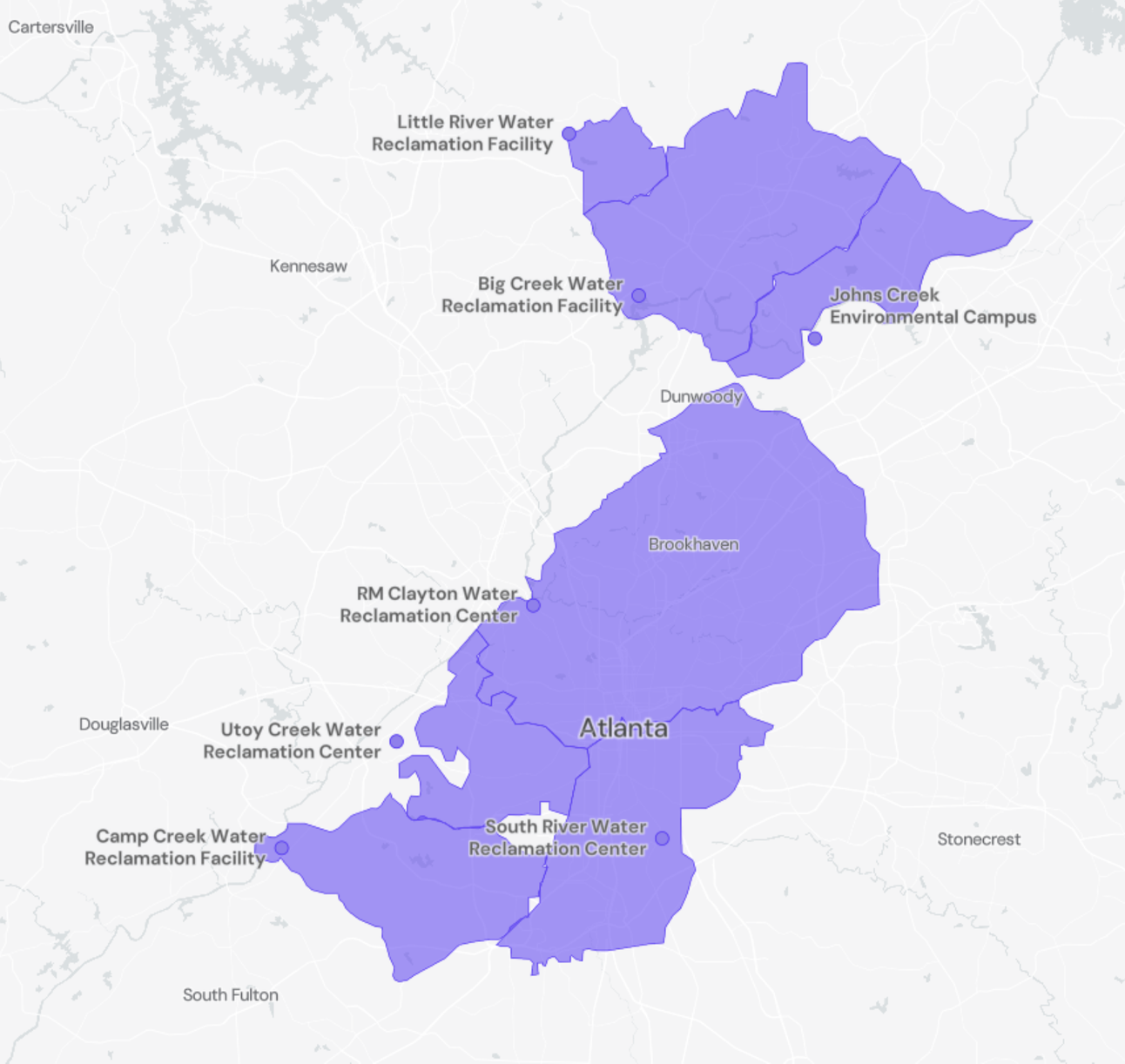
If you notice any bugs on the site or have any comments about it, please continue to send your feedback via email wwscan_stanford_emory@lists.stanford.edu. We thank you for your partnership!
Infectious Disease Target Review
Currently monitoring a suite of Respiratory, Gastrointestinal and Outbreak Pathogens of Concern

The methods for our assays are in the public domain and links for these are provided at the end of the newsletter.
Respiratory Pathogens
SARS-CoV-2, Influenza A & B, Respiratory Syncytial Virus, Human metapneumovirus, Human Parainfluenza & EV-D68
SARS-CoV-2 RNA concentrations have between 25,400 and 146,000 copies/gram in the last two weeks. The chart below shows the raw data since December 2022 and the population-weighted aggregated trend line for all 8 Georgia sites when the data is normalized by PMMoV. The aggregated line and the National Levels benchmarks illustrate that SARS-CoV-2 N gene RNA concentrations among Georgia sites are within the middle third level of all concentrations measured in the last year.
As of 12/8/23, Big Creek, College Park, Columbus, Johns Creek, Little River, and South River are in the HIGH (6 sites) category; RM Clayton and Utoy Creek are in the MEDIUM (2 sites) category.
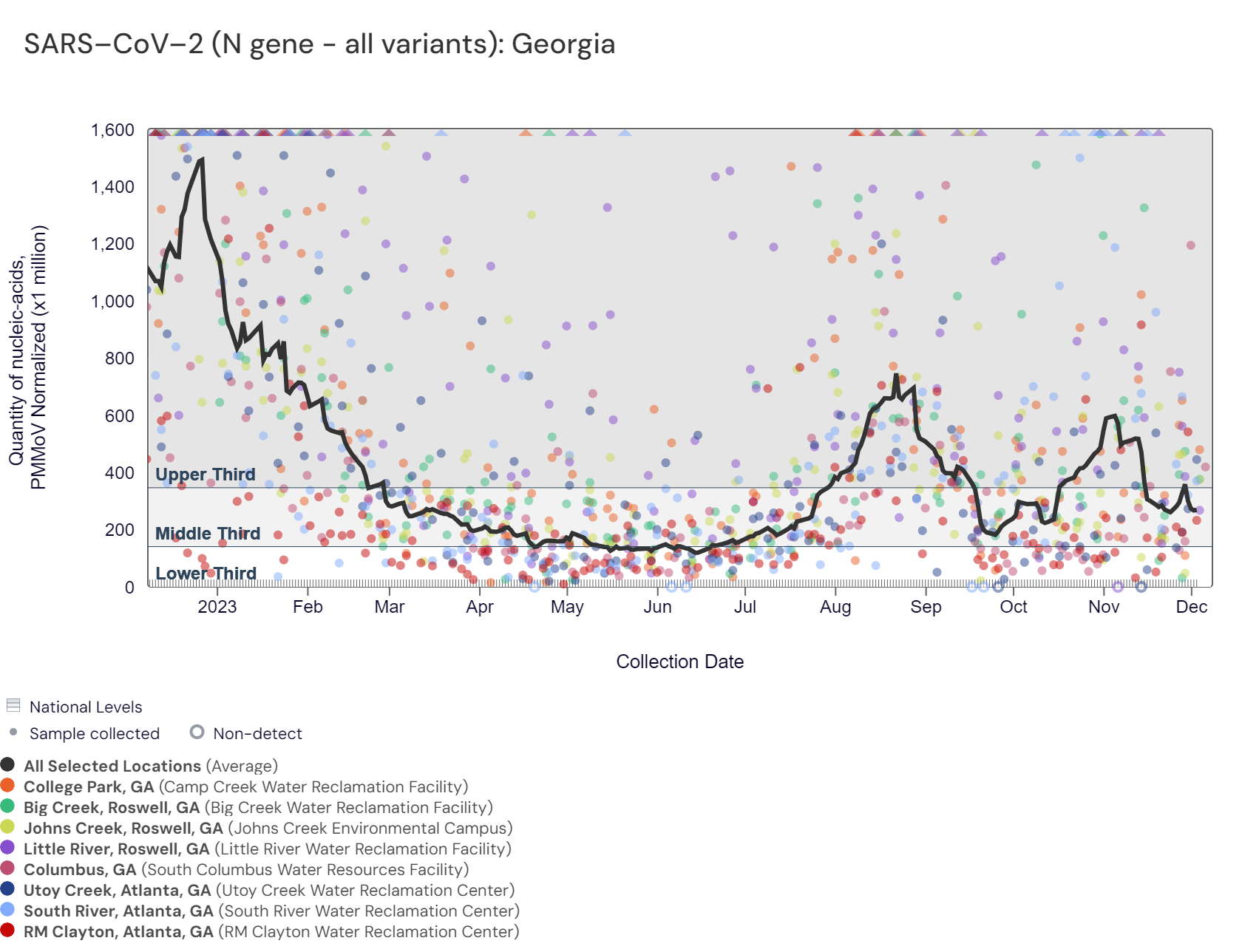
Influenza A (IAV) RNA concentrations are less than 8,100 copies/gram. IAV has been detected at at all Georgia sites within the last few weeks as seen in the heat map below. As of 12/8/2023, there are 7 sites in the LOW Wastewater Category and South River is in the HIGH (1 site) Wastewater Category. Both Big Creek and South River have had recent onsets of influenza A in wastewater.
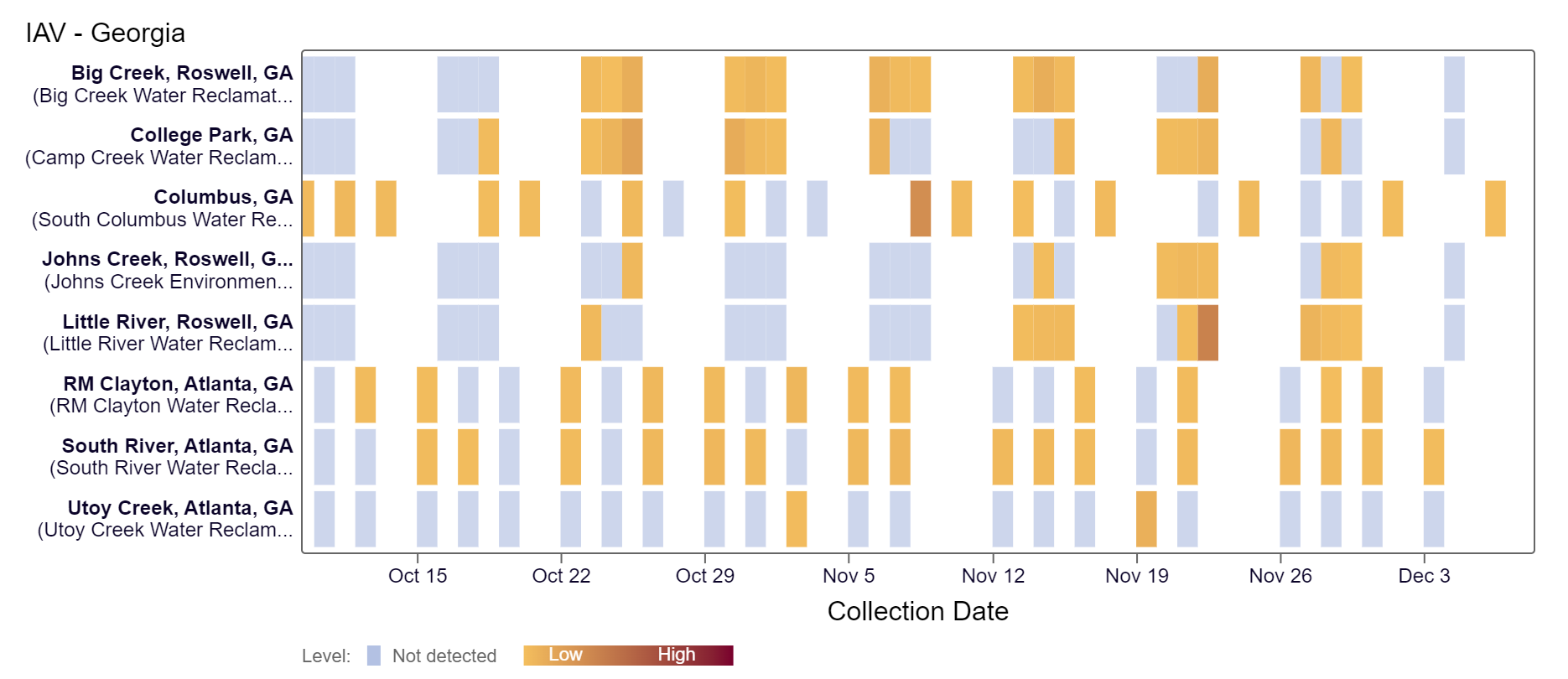
Influenza B (IBV) RNA has been detected at at all Georgia sites except Utoy Creek within the last few weeks, according to the heat map below. Concentrations are below 15,200 copies/gram. The highest concentrations have been detected at the Columbus site. As of 12/8/23, Columbus has had onset of influenza B in wastewater and is in the HIGH (1 site) Wastewater Category. Most sites are in the LOW (7 sites) category.

Respiratory syncytial virus (RSV) RNA concentrations were less than 70,000 copies/gram over the last two weeks. The chart below includes the raw data for each site since November 2022. The aggregated line and the National Levels benchmarks illustrate that RSV RNA concentrations among Georgia sites are within the upper third level of all concentrations measured in the last year. Most Georgia sites are in the HIGH (7 sites) Wastewater Category (in onset) as of 12/8/23; Utoy Creek is in the LOW (1 site) category. Recent aggregated levels are similar to last year's peak in RSV but concentrations are slightly higher.
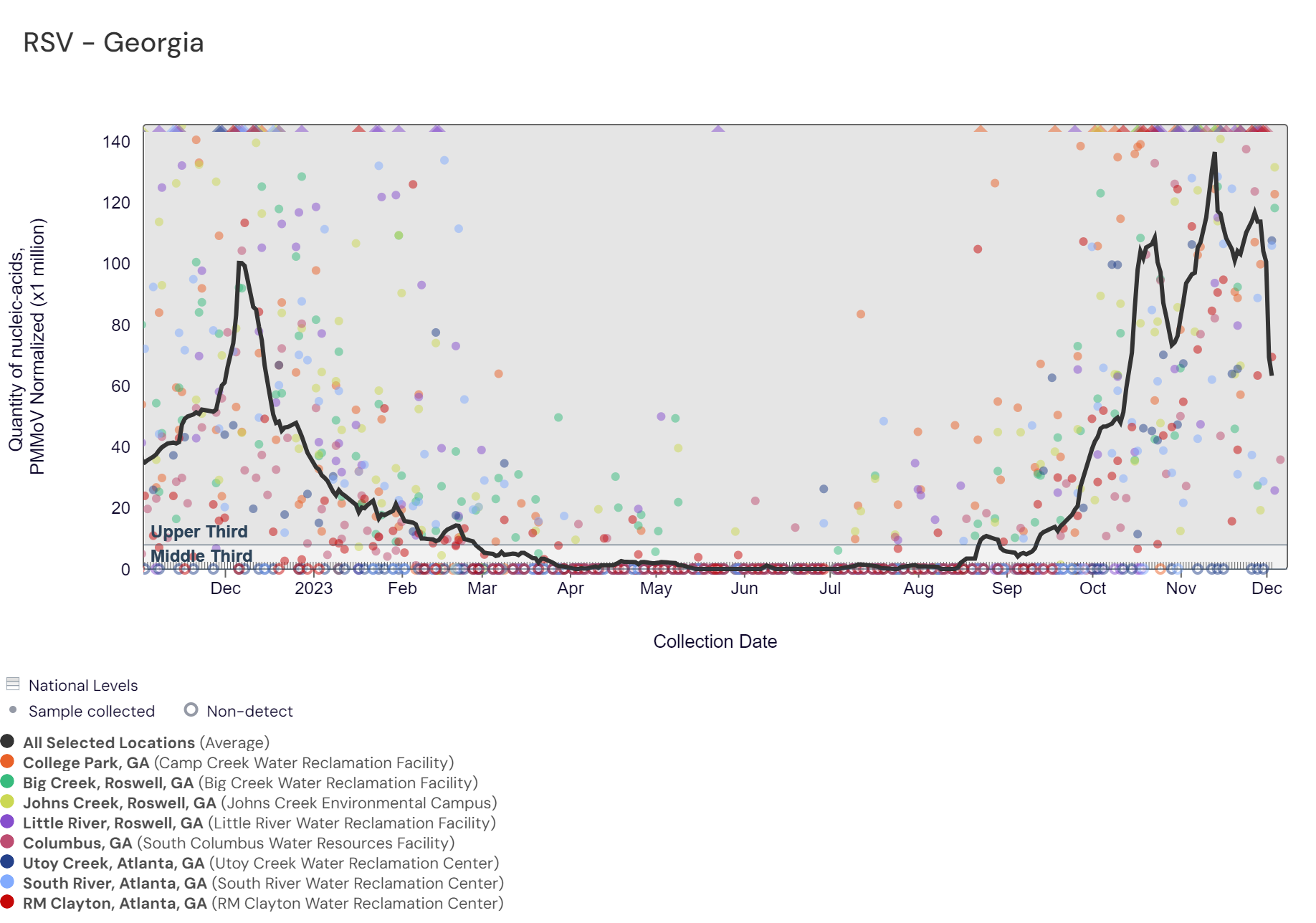
HMPV (human metapneumovirus) RNA detections are sporadic and are below 89,000 copies/g. Over the last month, the highest concentrations have been detected at the Johns Creek. Most Georgia sites are in the LOW (7 sites) Wastewater Category and Johns Creek is in the HIGH (1 site) Wastewater Category (in onset), as of 12/8/23.
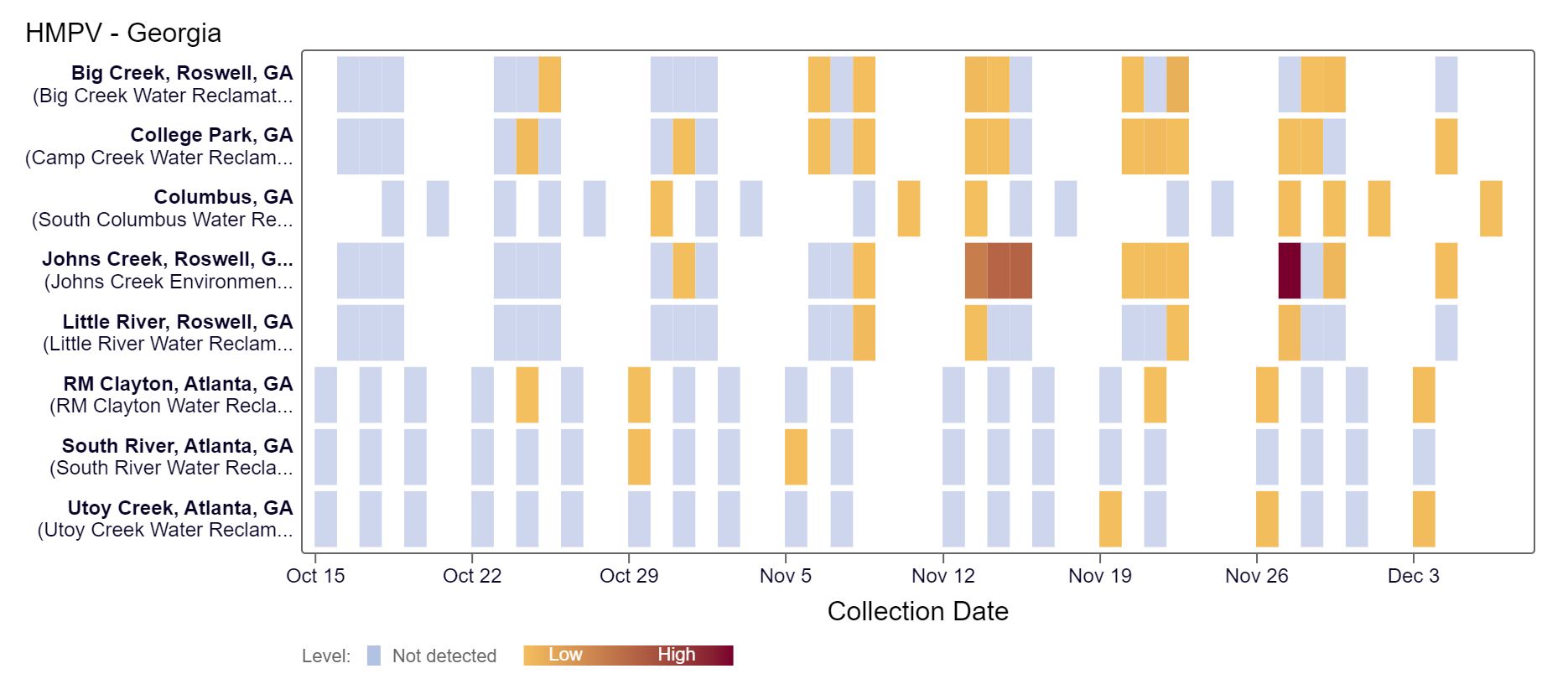
EV-D68 RNA is rarely detected at Georgia sites. There was a single detection at South River in the last two weeks, based on the heat map below. As a reminder, the color blue means the sample was non-detect for EV-D68 RNA and the colors get darker with higher concentrations. Because this is a new target, there is no category assigned and we are still establishing what an expected baseline amount of detection will be.
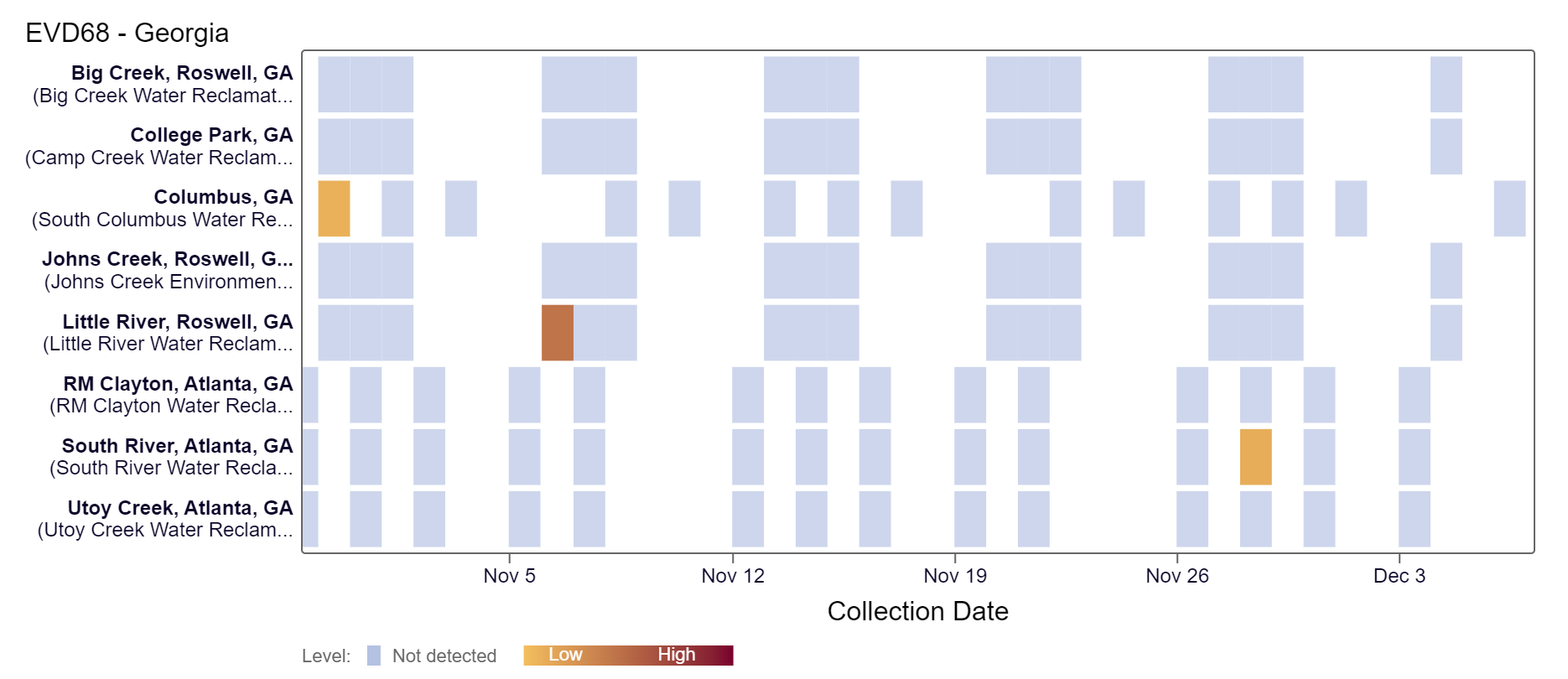
Parainfluenza RNA has been frequently detected in samples collected from most Georgia sites. Concentrations are less than 40,000 copies/g. The chart below shows the raw data since October 2023 and the population-weighted aggregated trend line for all 8 Georgia sites when the data is normalized by PMMoV. Because this is a new target, there is no category assigned and we are still establishing what an expected baseline amount of detection will be.

Gastrointestinal Pathogens
Norovirus GII, Rotavirus, and Human Adenovirus Group F
Norovirus GII (HuNoV GII) RNA concentrations range between 2,300,000 - 14,000,000 copies/g and the population-weighted average line for the 8 Georgia sites is within the upper third level.
As of 12/8/2023, Big Creek, College Park, Johns Creek, RM Clayton, and Utoy Creek are in the HIGH (6 sites) Wastewater Category; Columbus and Little River are in the MEDIUM (2 sites) category.

Rotavirus RNA concentrations have been between 35,000 - 1,300,000 copies/g over the last two weeks. The chart below shows the population-weighted average line is shown in black plus the 5-sample trimmed lines for each site. Because this is a new target, there is no category assigned and we are still establishing what an expected baseline amount of detection will be.
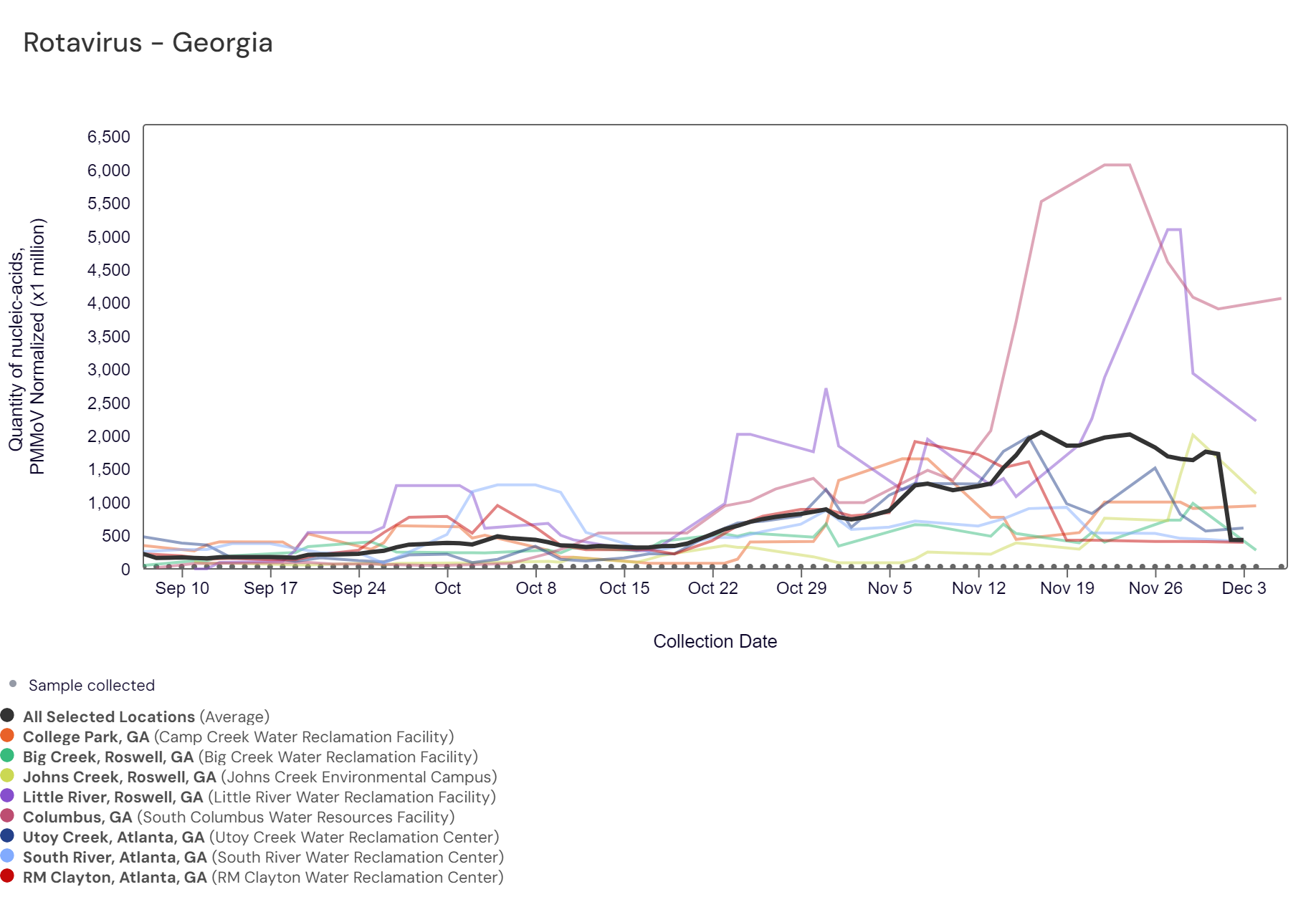
Human Adenovirus Group F DNA concentrations range between 2,700,000 and 23,000,000 copies/g. Because this is a new target, there is no category assigned and we are still establishing what an expected baseline amount of detection will be.
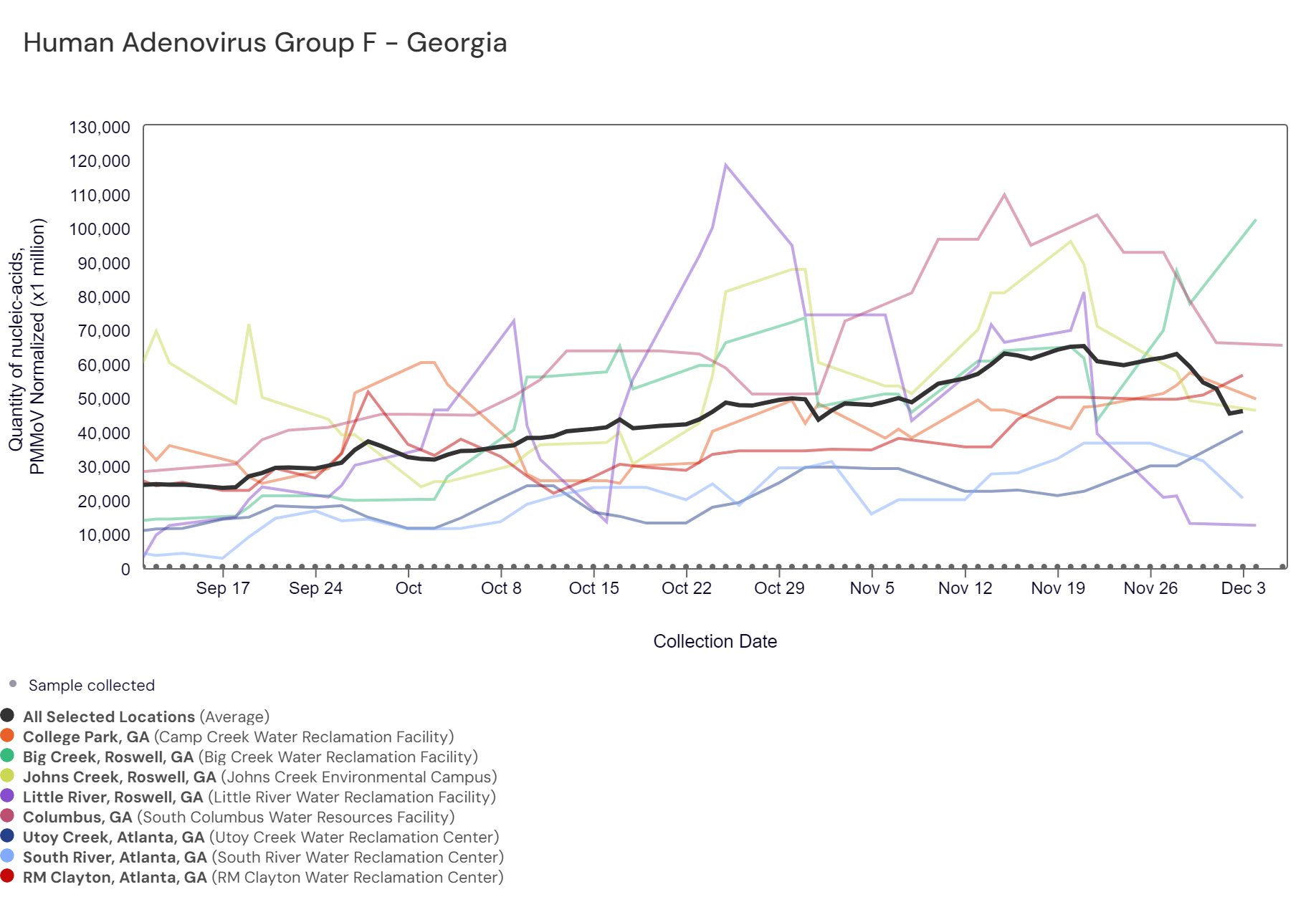
Other Pathogens of Concern
Mpox, Candida auris, and Hepatitis A
Mpox DNA results have been non-detect at most sites in the last 21 days except at RM Clayton and South River, where there were detections on 11/28/23 and 12/3/23. This heat map shows data since July 2022. Sites are labeled in the rows and each date a sample was collected as a column. The color blue means the sample was non-detect for mpox DNA and the color maroon means Mpox DNA was detected. White indicates no sample was collected. All 8 Georgia sites are in the LOW Wastewater Category as of 12/8/23.

Candida auris DNA has not been detected in the last two weeks, based on the heat map below that dates back to 9/5/2023. Because this is a new target, there is no category assigned and we are still establishing what an expected baseline amount of detection will be.
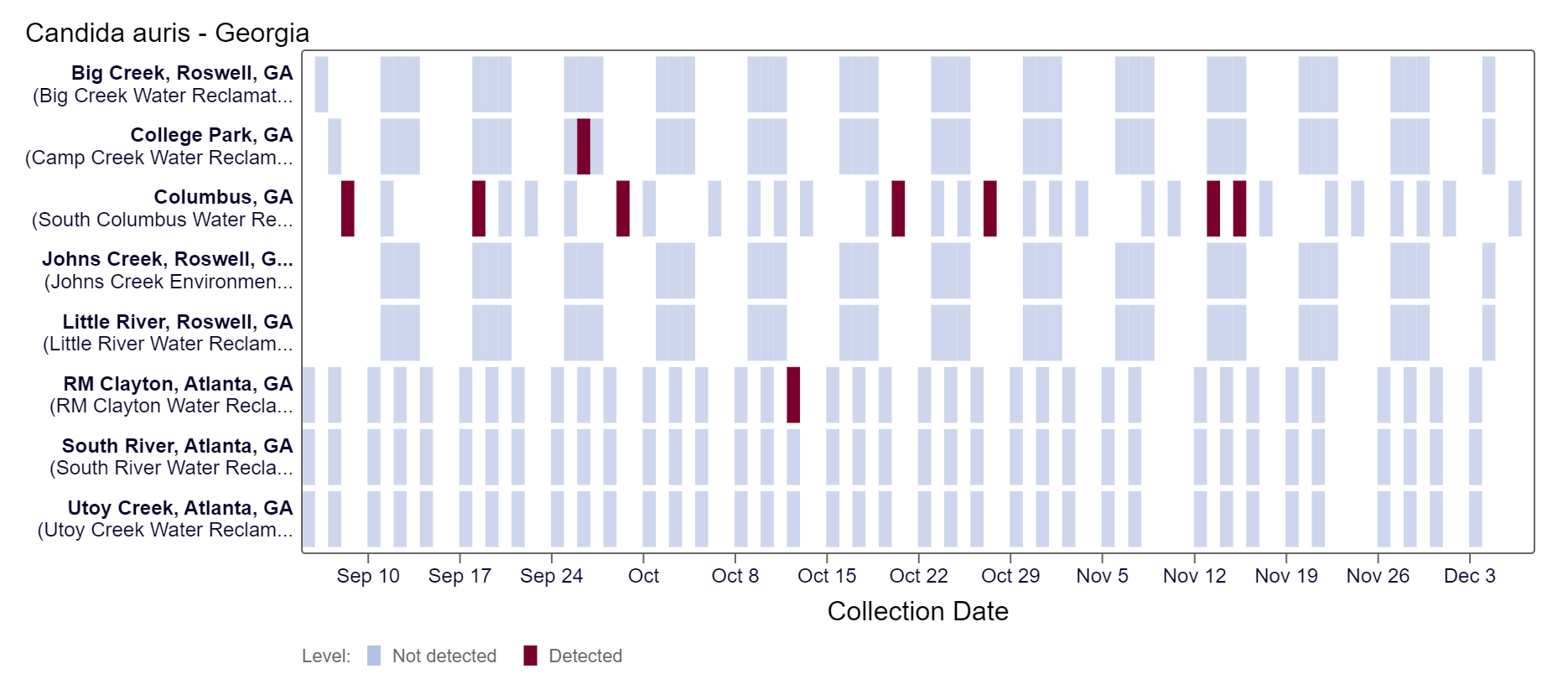
Hepatitis A RNA detection is sporadic and has only been detected at RM Clayton and Big Creek over the last two weeks. Because this is a new target, there is no category assigned and we are still establishing what an expected baseline amount of detection will be.
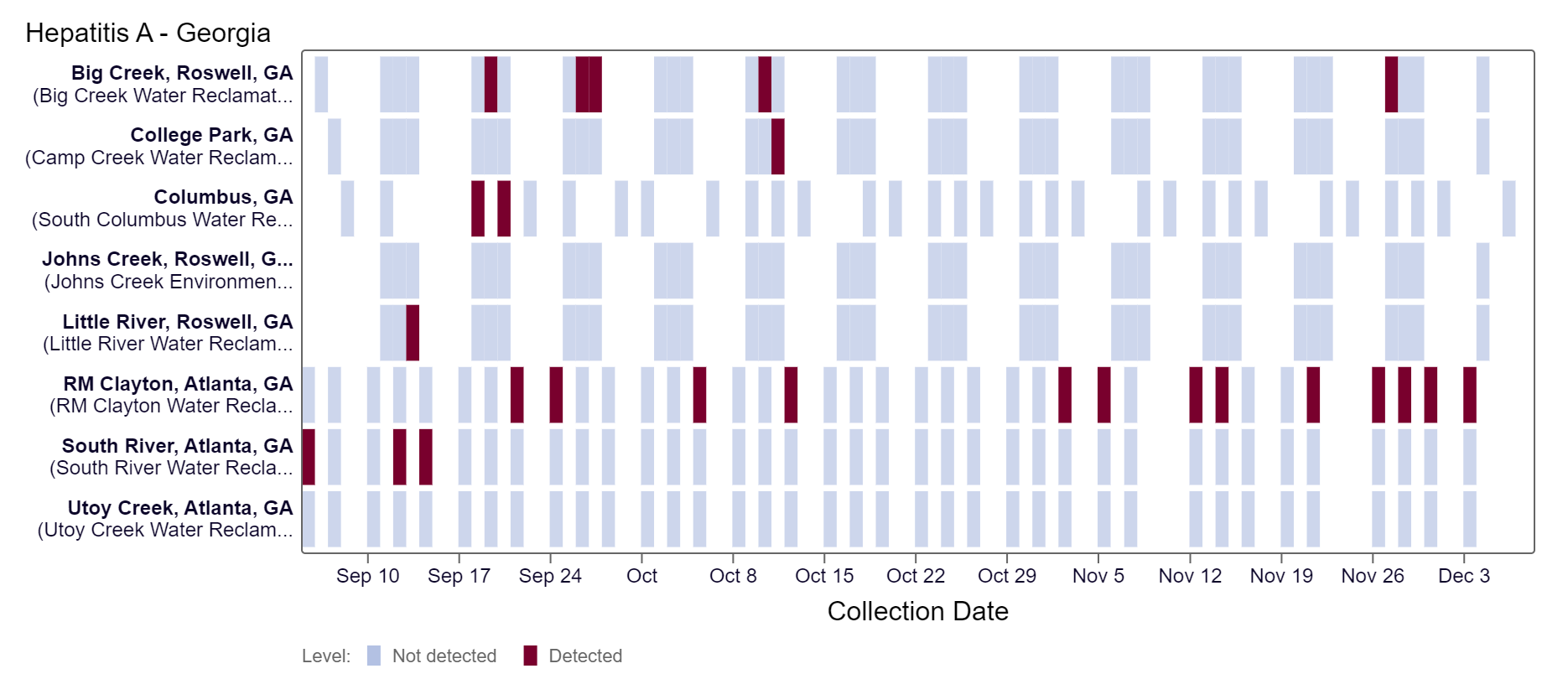
WWSCAN protocols and methods in peer reviewed publications
Protocols (Pre-analytical methods and SARS-CoV-2 analytical methods including controls):
- High Throughput RNA Extraction and PCR Inhibitor Removal of Settled Solids for Wastewater Surveillance of SARS-CoV-2 RNA
- High Throughput pre-analytical processing of wastewater settled solids for SARS-CoV-2 RNA analyses
- Quantification of SARS-CoV-2 variant mutations (HV69-70, E484K/N501Y, del156-157/R158G, del143-145, LPPA24S, S:477-505, and ORF1a Del 141-143) in settled solids using digital RT-PCR
- High Throughput SARS-COV-2, PMMoV, and BCoV quantification in settled solids using digital RT-PCR
Pre-prints and peer-reviewed publications provided WWSCAN methods:
- SARS-CoV-2
- Influenza, Human metapneumovirus, Respiratory syncytial virus, Human parainfluenza
- Mpox
- Norovirus GII
- Adenovirus group F, Rotavirus, Candida auris, Hepatitis A
- Enterovirus D68
Related News
The next stakeholder meeting will take place Friday, January 12th @ 12 PM EST. You can use this zoom link to join. Hope to see you there!
